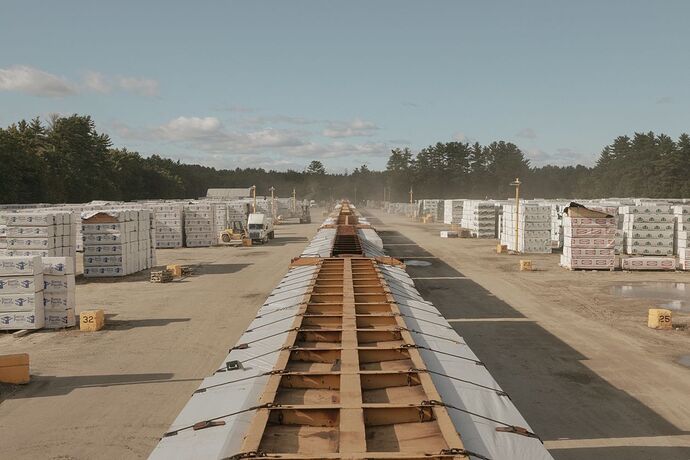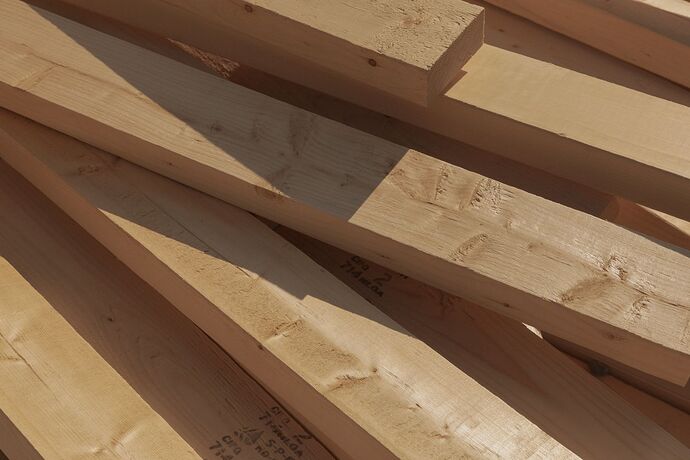Lumber Prices Fall Back to Around Their Pre-Covid Levels
Rising interest rates have taken an ax to one of the pandemic’s hottest commodities
Futures prices for lumber are down more than 70% from a March peak.
Photographs by Landon Speers for The Wall Street Journal
Sept. 27, 2022 5:30 am ET
Lumber prices have fallen to their lowest level in more than two years, bringing two-by-fours back to what they cost before the pandemic building boom and pointing to a sharp slowdown in construction.
Lumber futures ended Monday at $410.80 per thousand board feet, down about one-third from a year ago and more than 70% from their peak in March, when the Federal Reserve began raising interest rates to fight inflation.
Wood prices crashed in the early days of the 2020 lockdown, but they exploded that summerwhen stuck-at-home Americans remodeled en masse and suburban home sales surged. Two-by-four prices nearly tripled the prepandemic record in an early sign of the inflation and broken supply chains that would bedevil the economic reopening.
But lumber has led the way down for commodities since the central bank took aim at rising consumer prices and the overheated housing market. For two years, climbing lumber costs lifted home prices. Now home builders say that cheaper wood is giving them wiggle room to offer buyer incentives and to trim prices without crimping their profit margins.
Wood-pricing service Random Lengths said its framing-lumber composite index, which tracks cash sales in several species, fell last week to $529, down more than 60% from early March. Now that supply issues have eased and the highest mortgage rates in more than a decade have slowed home sales, buyers are no longer hoarding lumber for fear of running out.
“All the urgency over the past two years—‘give me everything you can’—that’s basically over. Lumberyards are not scared of the price going up,” said Michael Goodman, director of specialty products at wholesaler Sherwood Lumber Corp., which his family owns and operates. The Melville, N.Y., distributor sells framing lumber and plywood to building-supply companies, truss manufacturers and shipping-crate makers around the country. “The sexy lumber world is coming to an end, unfortunately,” he said.
A Massachusetts facility of Sherwood Lumber, which says the urgent demand for lumber over the past two years is over.
Lumber has led the way down for commodities since the Federal Reserve began raising interest rates to fight inflation.
The rate at which new U.S. housing is being built is down about 13% from April, when residential construction activity hit its highest level in more than a decade, according to the Census Bureau. An increase in new multifamily buildings has offset a sharper decline in the construction of single-family homes, which typically use about three times as much lumber per unit as apartments.
The issuance of building permits for residential construction has declined steadily since March. The National Association of Home Builders said its measure of builder confidence declined in September for the ninth straight month, to a level of pessimism not registered since 2020’s Covid-19 lockdown and the 2008 housing crash.
Mill executives, analysts and timber consultants who gathered last week at a World Forestry Center conference in Portland, Ore., said the lumber sector is bracing for recession, though not a severe one.
U.S. housing startsSource: U.S. Census Bureau via St. Louis FedNote: Seasonally adjusted annual rate
2018’19’20’21’2200.250.500.751.001.251.501.75million unitsMultifamilySingle-family
Paul Jannke of Forest Economic Advisors LLC said his firm forecasts that lumber consumption will decline by as much as 2.5% this year and up to 4.5% in 2023 as home construction stalls and remodeling demand reverts to normal following the pandemic renovation boom.
Despite the steep drop in consumption, Mr. Jannke and others expect wood prices to be much higher than during previous downturns—in the $400s per thousand board feet, rather than the $200s—due to record-low inventories among dealers and rising mill costs, especially in British Columbia, where forest fires, wood-boring beetles and conservation efforts have reduced the supply of logs.
The lumber price that mills in western Canada need to break even is about $500 per thousand board feet, which means that they are likely to choke back output whenever cash prices for the spruce, pine and fir boards they saw drop below that, Mr. Jannke said.
Mills there, as well as in the U.S. Pacific Northwest and the South, have already begun cutting back. Canfor Corp., one of North America’s largest lumber producers, said it began a two-week curtailment Monday at most of its facilities in British Columbia. Work will resume at reduced operating schedules aimed at trimming the Vancouver firm’s production capacity by about 200 million board feet, or about 15% of last year’s fourth-quarter output.
Pressure on lumber prices is down as supply issues have eased and surging mortgage rates have slowed home sales.
The consolidation of North America’s sawmills by a few big firms, such as Canfor and West Fraser Timber Co., has hastened the speed at which production is choked back in response to falling prices and should buoy prices, said Håkan Ekström of Wood Resources International LLC.
“Markets are a little more controlled with fewer mill owners,” he said. “When there were more owners, everyone waited for someone else to slow down.”
Dealers like Sherwood’s Mr. Goodman say that the quick curtailment triggers are reason to load up on wood. “There’s upside risk of waiting and really no downside to buying right now, that’s what we’re telling our customers,” he said.



